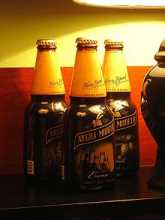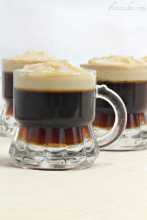Piraat
Drinking a big bottle of this type of beer is about equivalent to eating a whole loaf of bread in one sitting in terms of how filling it is. By the time I finished the Piraat and poured my first glass of Trois Pistoles, I realized I couldn't possibly drink it and was forced to ask my wife to painstakingly pour it back into the bottle for me so I could drink it the next day.
Someone once described Piraat as one of the five best beers in the entire world. With ratings like that, I'm not sure I even feel qualified to comment on it! But I will say this:
It has a picture of a pirate and a picture of a pirate ship on the label, it's called “pirate” (well, close enough), it will blow your socks off if you're not careful, and it's damn tasty like all Belgian beers. So rather than trying to describe the qualities of such Beer Royalty as this, I'll just tell you I recommend it and leave it at that. Just don't imagine you can drink two of them, because you can't.








